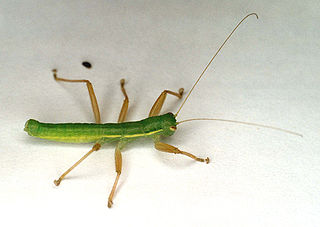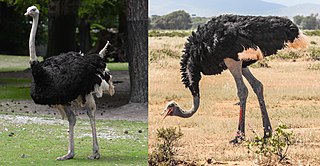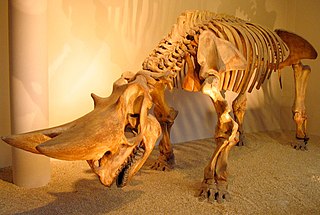
The Eocene is a geological epoch that lasted from about 56 to 33.9 million years ago (Ma). It is the second epoch of the Paleogene Period in the modern Cenozoic Era. The name Eocene comes from the Ancient Greek Ἠώς and καινός and refers to the "dawn" of modern ('new') fauna that appeared during the epoch.

Mantophasmatidae is a family of carnivorous wingless insects within the monotypic order Mantophasmatodea, which was discovered in Africa in 2001. Recent evidence indicates a sister group relationship with Grylloblattidae, and Arillo and Engel have combined the two groups into a single order, Notoptera, with Grylloblattodea and Mantophasmatodea ranked as suborders.

Amphicyonidae is an extinct family of terrestrial carnivorans belonging to the suborder Caniformia. They first appeared in North America in the middle Eocene, spread to Europe by the late Eocene, and further spread to Asia and Africa by the early Miocene. They had largely disappeared worldwide by the late Miocene, with the latest recorded species at the end of the Miocene in Africa. They were among the first carnivorans to evolve large body size. Amphicyonids are colloquially referred to as "bear-dogs".

Ostriches are large flightless birds. Two living species are recognised, the common ostrich, native to large areas of sub-Saharan Africa, and the Somali ostrich, native to the Horn of Africa.

Embrithopoda ("heavy-footed") is an order of extinct mammals known from Asia, Africa and Eastern Europe. Most of the embrithopod genera are known exclusively from jaws and teeth dated from the late Paleocene to the late Eocene; however, the order is best known from its terminal member, the elephantine Arsinoitherium.

Megistotherium is an extinct genus of hyaenodont belonging to the family Hyainailouridae that lived in Africa.

Dissopsalis is a genus of teratodontine hyaenodonts of the tribe Dissopsalini. The older species, D. pyroclasticus, lived in Kenya during the middle Miocene, while the type species, D. carnifex, lived in Pakistan and India during the middle to late Miocene.

Martin Pickford is a lecturer in the Chair of Paleoanthropology and Prehistory at the Collège de France and honourary affiliate at the Département Histoire de la Terre in the Muséum national d'Histoire. In 2001, Martin Pickford together with Brigitte Senut and their team discovered Orrorin tugenensis, a hominid primate species dated between 5.8 and 6.2 million years ago and a potential ancestor of the genus Australopithecus.

Atelestidae is a family of flies in the superfamily Empidoidea. The four genera were placed in a separate family in 1983; they were formerly either in Platypezidae or considered incertae sedis. While they are doubtless the most basal of the living Empidoidea, the monophyly of the family is not fully proven. The genus Nemedina seems to represent a most ancient lineage among the entire superfamily, while Meghyperus is probably not monophyletic in its present delimitation, and it is liable to be split up eventually, with some species being placed elsewhere. In 2010, the genus Alavesia, previously only known from Cretaceous fossils, was found alive in Namibia, subsequent species were also described from Brazil.

Cylindracanthus is an extinct, enigmatic genus of marine ray-finned fish with fossils known throughout North America, Europe, Asia and Africa from the Late Cretaceous to the late Eocene, with potential Oligocene records and a possible Miocene record also known. It is exclusively known from its distinctive partial remains, which are long cylindrical bony spines that are usually considered rostrum fragments, as well as some associated teeth. These spines are abundant & widespread throughout this timespan, and are useful indicators of a nearshore marine environment, but the taxonomic identity of the fish is still highly uncertain and debated.

Adapisoriculidae is an extinct family of non-placental eutherian mammals which was present during the Paleogene and possibly the Late Cretaceous. They were once thought to be members of the order Erinaceomorpha, closely related to the hedgehog family (Erinaceidae), because of their similar dentition, or to be basal Euarchontans. They were also thought to be marsupials at one point. Most recent studies show them to be non-placental eutherians, however.
Notnamaia is a genus of primates that lived in Africa during the early middle Eocene. It contains one species, N. bogenfelsi. Its describers considered it to be an early simian, but other researchers have generally placed it within Strepsirrhini, possibly aligned with the djebelemurids or caenopithecines.

Falcatodon is an extinct genus of hyainailourid hyaenodonts of the subfamily Hyainailourinae, from the Early Oligocene (Rupelian) of the Faiyum Oasis depression in Egypt.
Sectisodon is an extinct genus of hyainailourid hyaenodont mammal of the subfamily Hyainailourinae from early Oligocene to early Miocene deposits in Egypt and Uganda.

The geology of Namibia encompasses rocks of Paleoproterozoic, Mesoproterozoic and Neoproterozoic and Paleozoic to Cenozoic age. About 46% of the countryʼs surface are bedrock exposure, while the remainder is covered by the young overburden sediments of the Kalahari and Namib deserts.

The Black Crow Limestone is an Early Eocene geologic formation in the Sperrgebiet, ǁKaras Region of southwestern Namibia. The limestones of the approximately 10 metres (33 ft) thin formation were deposited in a lacustrine to paludal environment. The formation provides many fossil mammals and amphibians, reptiles, fresh water snails and fish.

Dissopsalini is an extinct tribe of teratodontid hyaenodonts. Fossil remains of these mammals are known from early to late Miocene deposits in Asia and Africa.

Hyainailourinae ("hyena-cats") is an extinct subfamily of hyainailourid hyaenodonts that lived in Africa, Asia, North America and Europe from the middle Eocene to middle Miocene. They appeared in Africa about 47.8 Ma ago and soon after spread as far as East Asia.
Nanogale is an extinct genus of tenrecomorph from the Eocene of Namibia. It is a monotypic genus containing the species N. fragilis.













